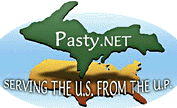By Mary Drew at Pasty Central (Mdrew) on Thursday, August 20, 2015 - 08:04 am:
Paul and Nathalie Brandes take us on a tour of the Delaware Copper Mine in Keweenaw County. Capt. Paul told me that Dr. Nat had not been there before this trip and it had been 10 years since he toured this mine, so it was time to check it out. Here's what he had to say about the expedition:
"After we talked with Tom Poynter, we discovered they have made a lot of changes since the last time I was there. For one, they now have electricity! For years, they had relied on a generator to supply power to their residence, gift shop, and underground lighting. Now that they have electricity, not only have they lit up more of the underground workings, they have also expanded the self-guided tour to the No. 3 shaft, a distance of over 1,400 feet from the bottom of the stairs at the No. 1 shaft. The tour still follows the first level of the mine, approx. 100 feet below the surface. Like C&H, Delaware followed a conglomerate copper vein at a 24 degree angle down to the 10th level, approx. 1,440 feet below the surface; however, everything below the first level is flooded with water.
Before you enter the mine, you watch a short video. Part of that video documents where divers dove down to the 4th level to explore the workings. Apparently this group dives there every year to explore more areas that are accessible.
Also part of the tour is an ancient trench where the pre-historic peoples searched for copper in the hillside. In fact, many of the mines up here got their start in the 1840’s because they (the mining companies) drove shafts either on or very near pre-historic pits all along the Peninsula."
Quite interesting to be able to go down underground and see what it was like back in the mining days here in the Keweenaw. Like their website says: It's a unique combination of entertainment and education.















